The Pinarello Dogma XC was designed with Ineos Grenadiers rider Tom Pidcock, taking the win in the first round of the UCI XC World Cup in Nové Mêsto.
After a year of being ridden by Pidcock and Pauline Ferrand-Prévot, the Dogma XC is now ready to be commercially released.
The Dogma XC has remained largely the same from the first prototype, with only a few tweaks to the linkage, and has been made lighter at Ferrand-Prévot's request.
The bike available for purchase is largely the same as the one the two world champions are riding, but with some component changes.
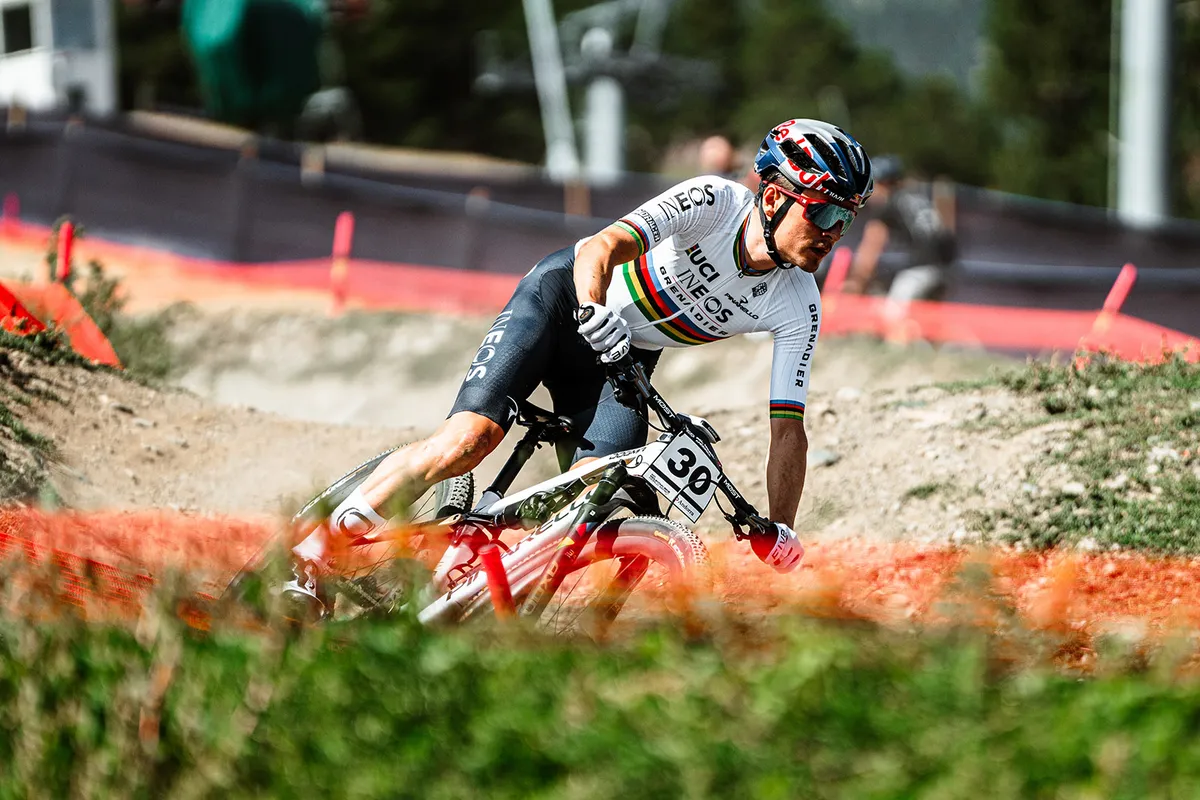
When designing the bike, there were four key objectives that Pinarello and Pidcock wanted to achieve: extreme stiffness for maximum reactivity, ability to adapt suspension travel for different courses, progressive kinematics, and lightness paired with handling ability for technical descents.
The bike has been designed for elite racers and has a ride feel to reflect this. The stiff rear triangle and bottom bracket provide impressive power transfer – when you're pushing out of the saddle, the Dogma XC flies.
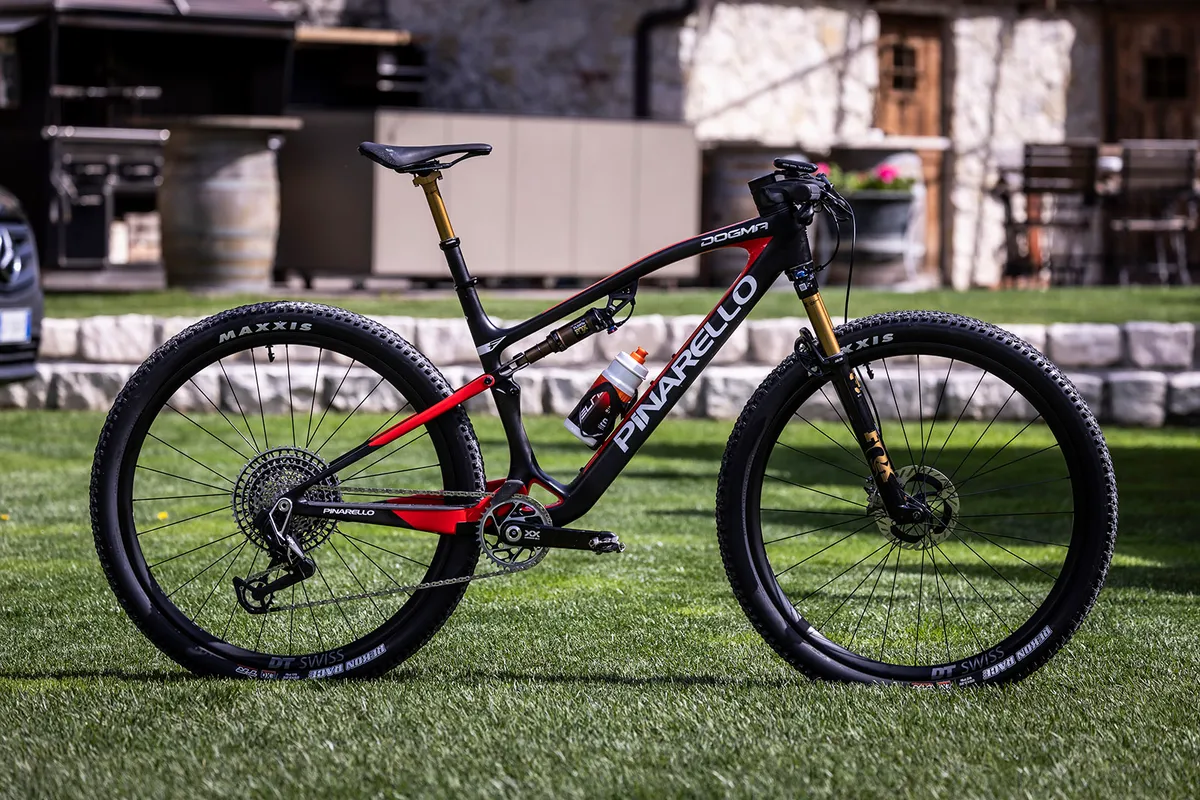
When it comes to the descents, there's no doubt this bike is more than capable of dispatching gnarly World Cup tracks, but it's not a forgiving ride and requires precision and commitment to get the most out of it.
The release of the Dogma XC marks Pinarello’s renewed attention to mountain biking, with plans to extend its MTB range in the pipeline.
Pinarello Dogma XC frame and suspension
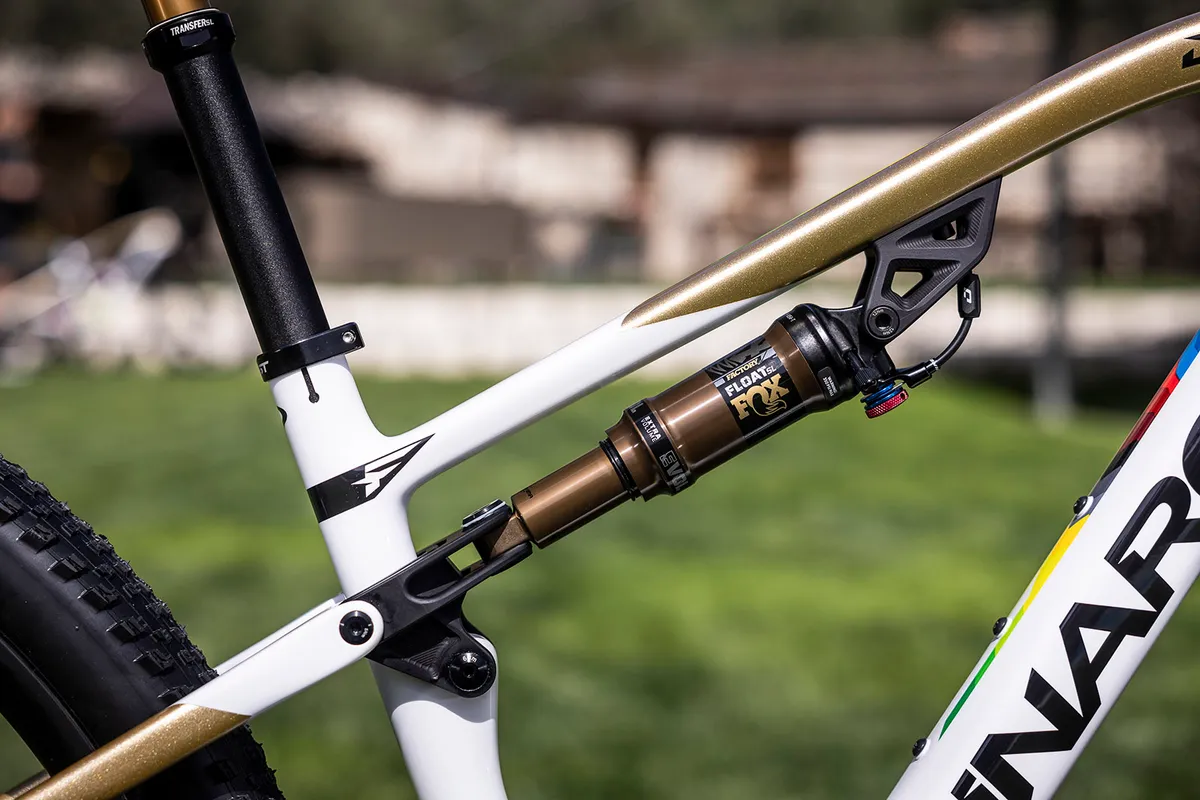
The Pinarello Dogma XC frame is constructed from the brand's premium carbon, Toray M40J, and has a distinctive shape.
The rear triangle has a patented asymmetric design, with increased stiffness in the non-driveside to compensate for the power applied by riders on the driveside, said to create an incredibly stiff platform for efficient power transfer.
The bottom bracket design is a unique aspect of the frame. It has a cut-out triangle that Pinarello says optimises stiffness, while providing space for an oversized bearing and strong pivot point for the rear triangle.
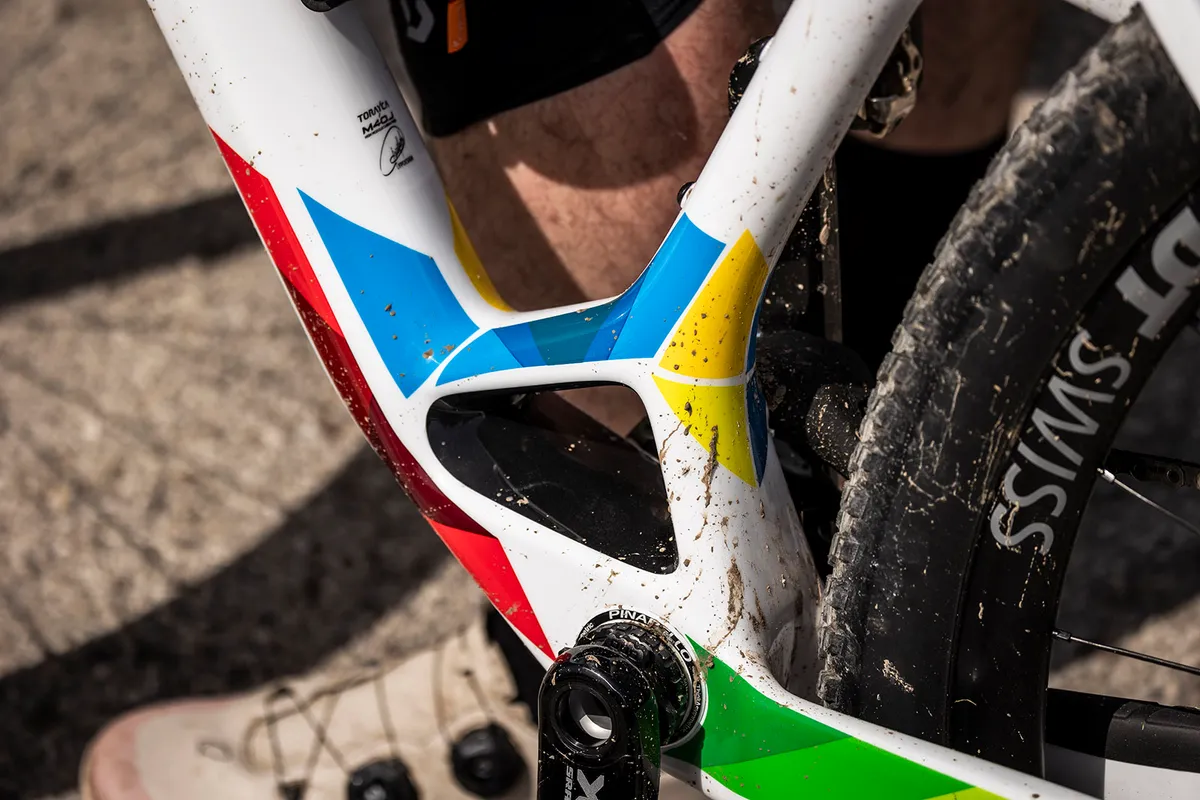
As is common on modern cross-country bikes, the Dogma XC has flexstays. Coupled with the geometry, this enables the travel to behave in a direct way. This design is said to help cut weight, improve stiffness and allow for superior connection between the rider and the rear wheel.
Pinarello's split rear-triangle design incorporates two 'semi-triangles' around the main rotation point, eliminating the need for a bridge from the seatstays and chainstays. This innovation is claimed to enable a reduced chainstay length, improved handling and enhanced reactivity.
The design is said to reduce mud build-up and provide clearance for tyres up to 2.4in.
The shock link is constructed from aluminium and enables adjustment to increase rear travel; 90mm (190x45mm) and 100mm (210x50mm) shocks are compatible, while the frame can accommodate either a 100mm or 120mm fork.
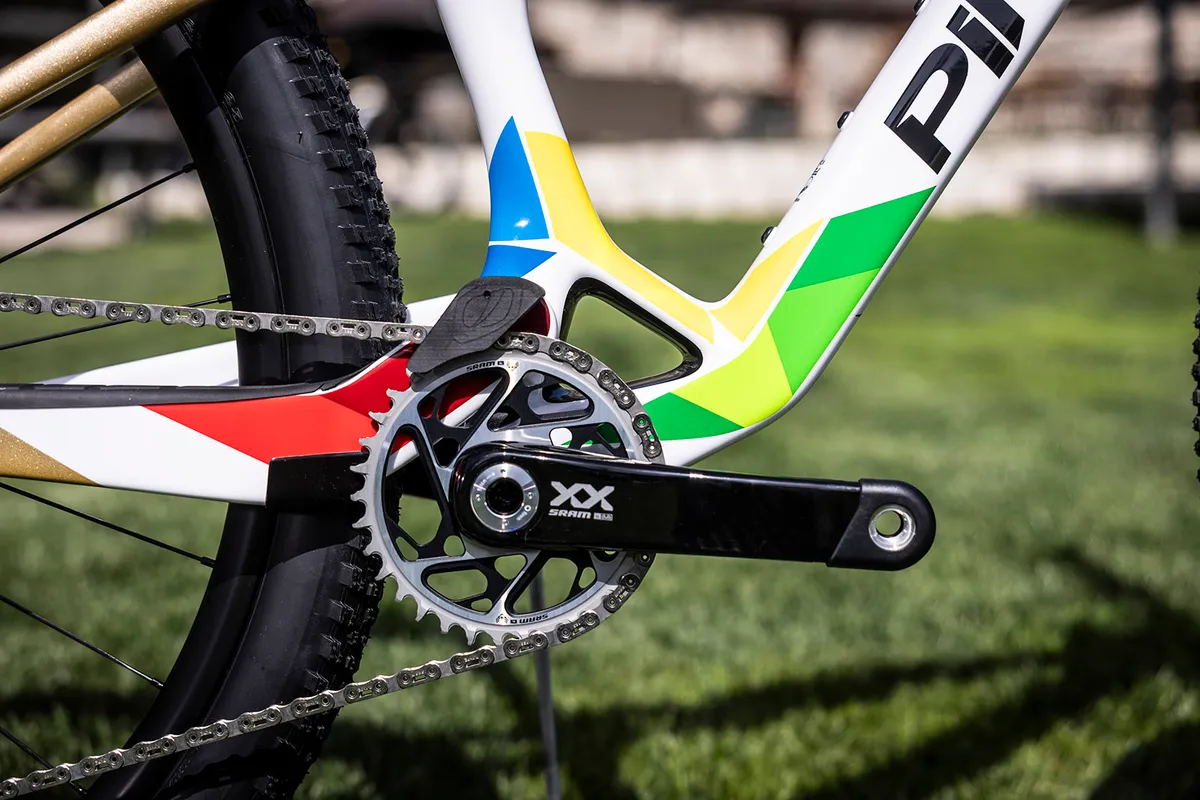
All models come equipped with electronic gears, however the frame is compatible with mechanical drivetrains and there is a hole in the frame under the chainstay protector for a cable.
The frame can accommodate a maximum 40t chainring and can fit two water bottles on the down tube, ideal for marathon racers or long training rides.
Pinarello Dogma XC geometry
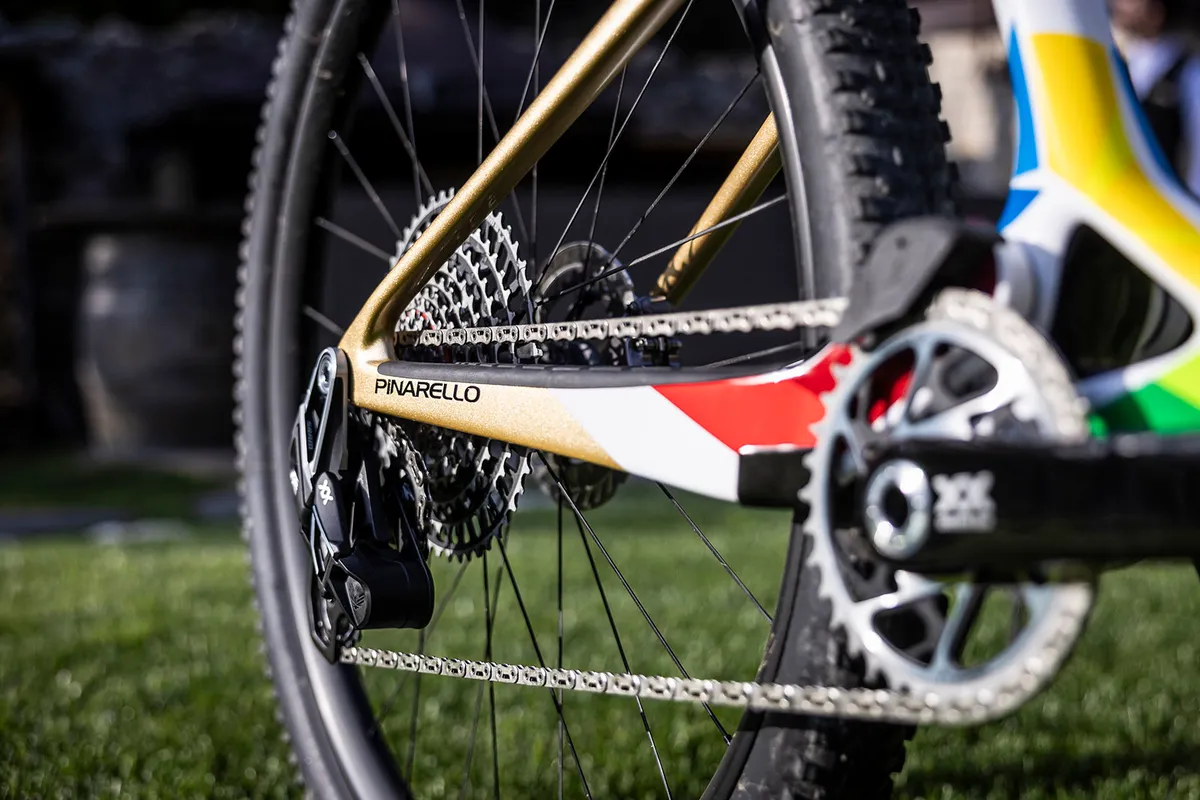
The Dogma XC is available in four sizes, from small to extra-large, and all feature a race-focused geometry.
Chainstay lengths stay consistent across all sizes at 425mm, which is quite short, especially on the large and extra-large frames.
The reach is longer than other bikes on the market, at 480mm for a size-large (the Orbea Oiz M-Team is 472mm and the Canyon Lux World Cup 470mm).
Head tube angles are 67.5 degrees for small and medium and increase by 0.5 degrees for the large and extra-large, which is the steeper end of the scale on modern XC bikes.
The seat tube angle is 75.5 degrees for the small and medium bikes, and 75 degrees for the large and extra-large, which is fairly steep for an XC bike.
Pinarello says changing the suspension configuration from 100mm front and 90mm (190x45mm) back to 120mm front and 100mm (210x50mm) back doesn’t alter the geometry.
| | S | M | L | XL |
|---|---|---|---|---|
| Seat tube angle (degrees) | 75.5 | 75.5 | 75 | 75 |
| Head tube angle (degrees) | 67.5 | 67.5 | 68 | 68 |
| Chainstay (mm) | 425 | 425 | 425 | 425 |
| Seat tube (mm) | 405 | 440 | 475 | 510 |
| Top tube (mm) | 578 | 608 | 639 | 669 |
| Bottom bracket height (mm) | 323 | 323 | 323 | 323 |
| Wheelbase (mm) | 1122.6 | 1152.7 | 1178.6 | 1209.2 |
| Standover (mm) | 747 | 747 | 749 | 751 |
| Stack (mm) | 585 | 590 | 606 | 620 |
| Reach (mm) | 427 | 455 | 480 | 505 |
Pinarello Dogma XC specification
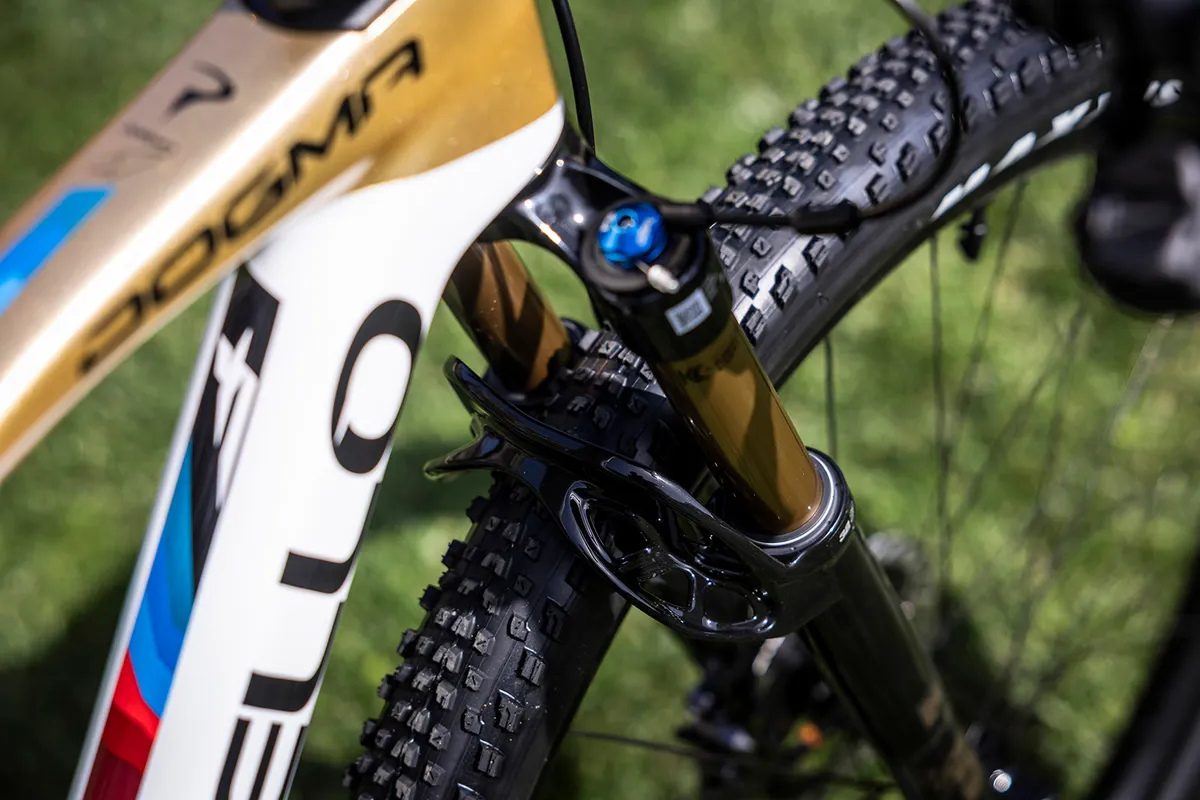
The Dogma XC is equipped with what the team at Pinarello thinks are the best kit options on the market. This means a mix of SRAM and Shimano components can be found on all bikes.
The new Fox 32mm Factory fork, with its reverse arch, new damper and 100g lighter weight than the previous generation, provides the suspension up front. This is paired with the Fox Float SL Factory shock; both have a cable-operated three-position lockout for on-the-fly adjustments.
Pinarello has equipped the bikes with 100mm of travel up front and 90mm out back. However, the frames are compatible with 120mm forks and 100mm shocks thanks to the adjustable shock mount. Pinarello says this is to make the bikes adaptable to the varying XC tracks on the circuit.
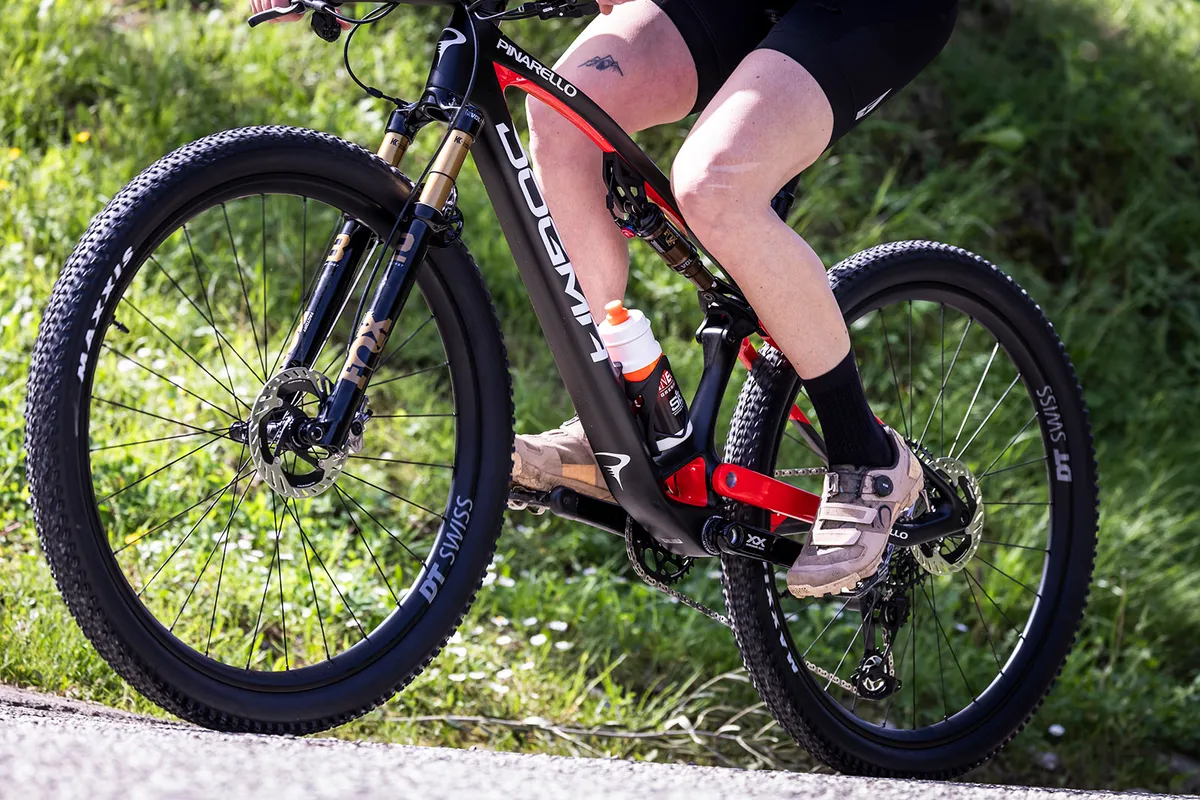
Fox also provides the cable-operated Transfer SL dropper post with 100mm drop and Kashima coating.
The bike sits on a DT Swiss XRC 1200 Spline carbon wheelset fitted with Maxxis Rekon Race 2.35in semi-slick racing tyres.
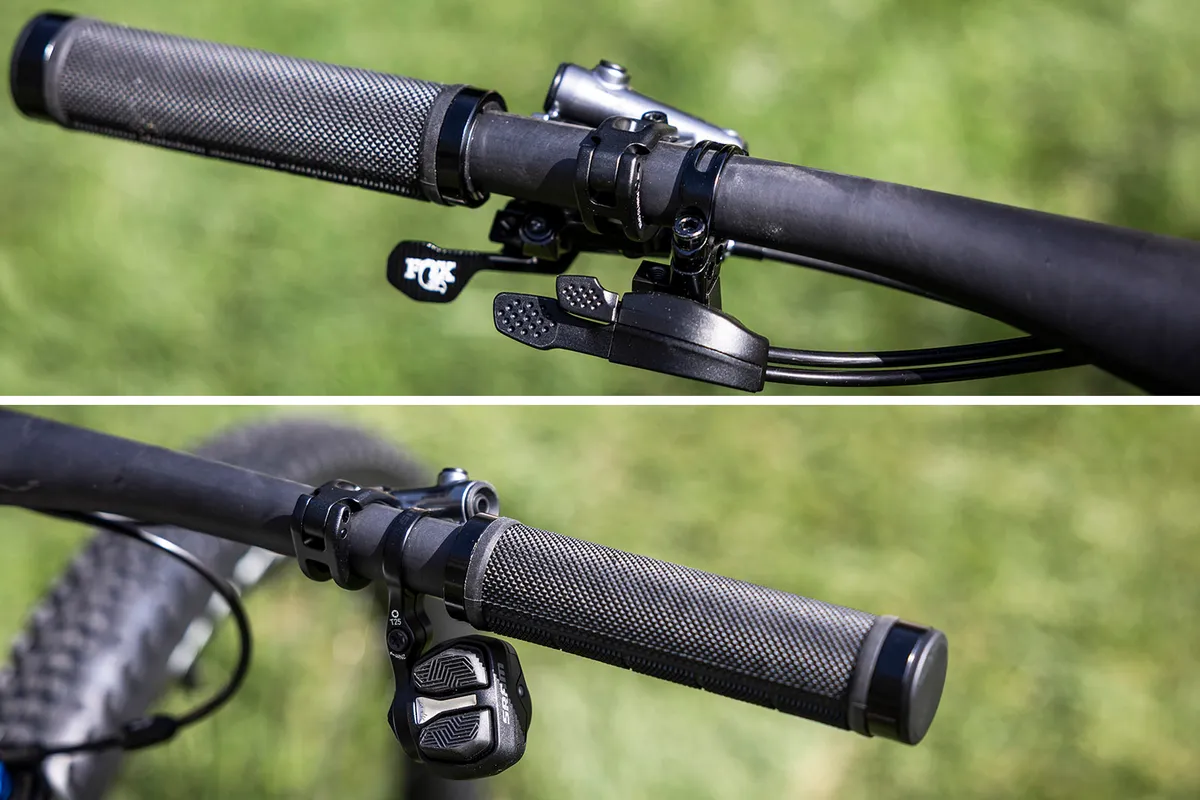
Pinarello has opted for SRAM electronic gearing, considering it to be the best on the market.
This top-spec model has the full XX SL Eagle AXS Transmission drivetrain, with the new Pod Ultimate Controller. Shimano XTR brakes provide the stopping power.
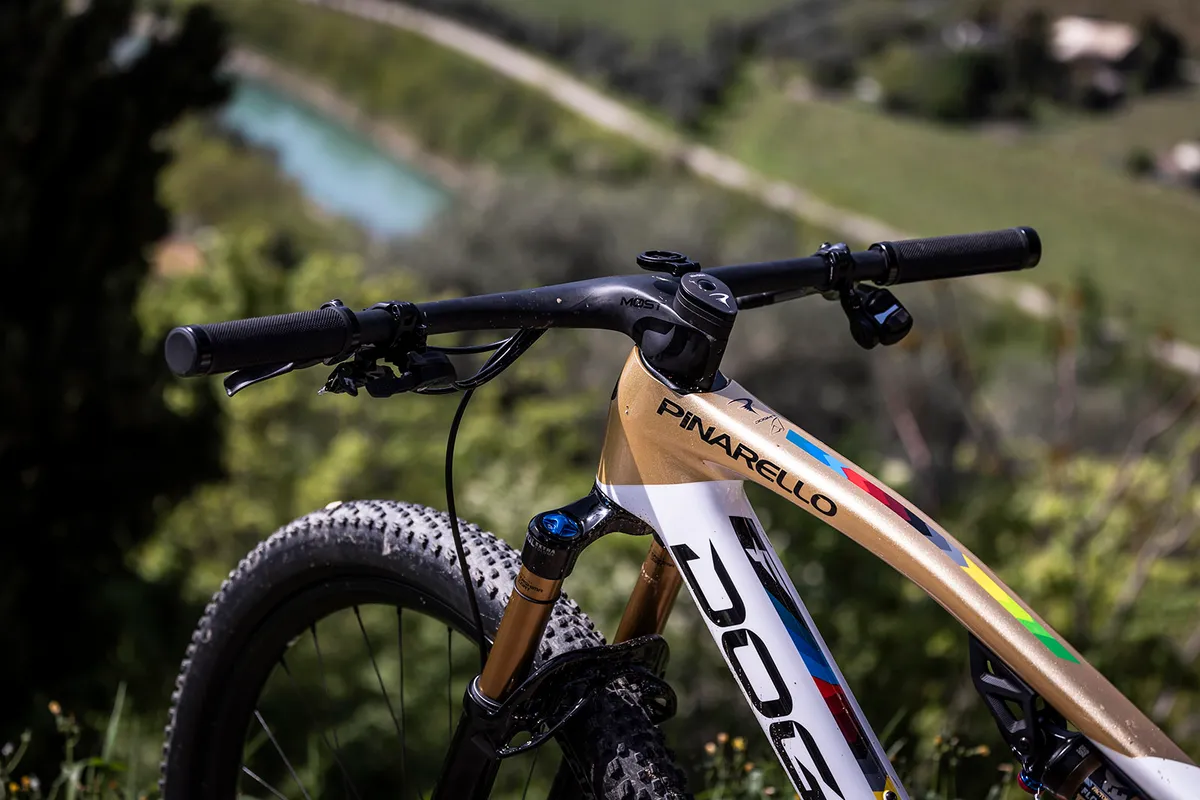
The cockpit comprises of Pinarello’s in-house brand MOST’s Talon Ultra XC integrated handlebar and stem with internal cable routing and a specific headset bearing that has an internal stopper at 60 degrees to prevent the handlebar overturning.
The grips and saddle also come from Pinarello’s in-house components brand, MOST.
Pinarello Dogma XC ride impressions
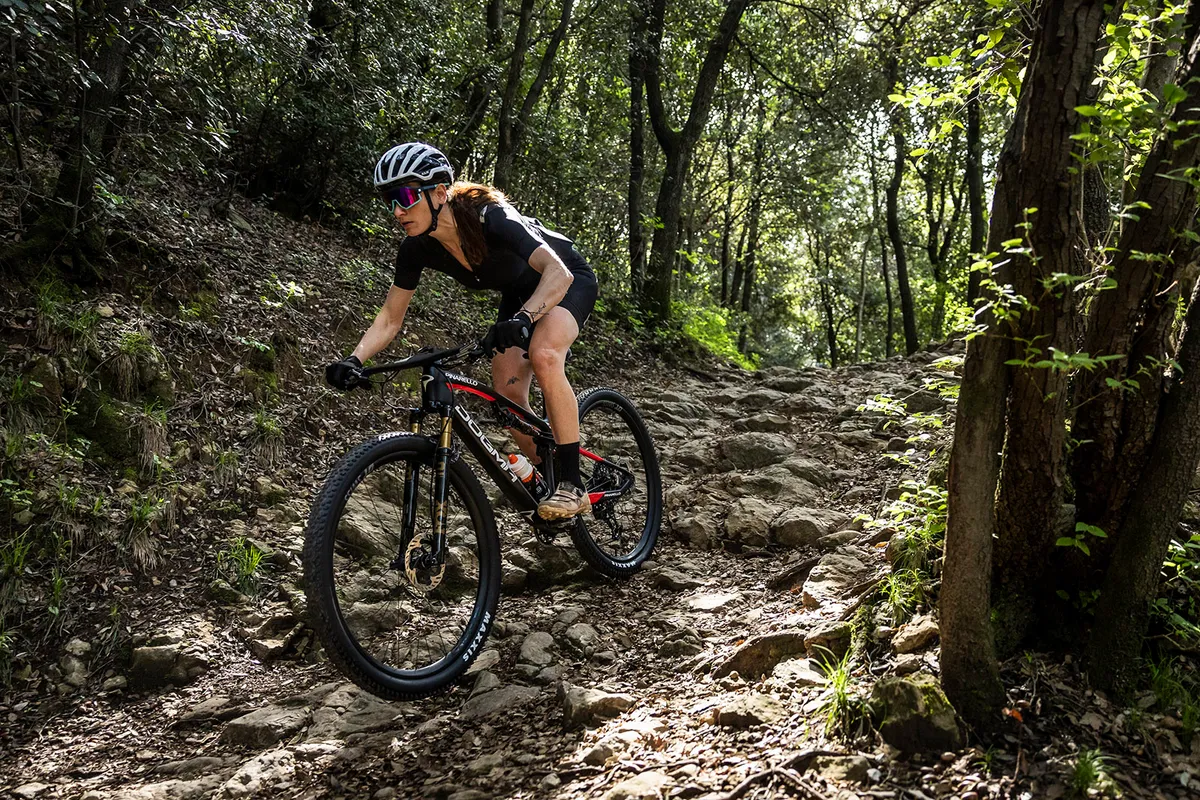
I spent a day riding the Dogma XC during its launch event north of Lake Garda, Italy.
The riding was a mix of rocky singletrack, paved mountain roads and forest tracks. Despite the dry and warm weather, recent rain had kept the trails in excellent condition, free from dust and offering good traction.
There were no long descents or flow, but technical climbs and rocky features provided good terrain to get a feel for how the Dogma XC rides.
My test bike was a size large and I set it up with 21psi in the front tyre and 23psi in the rear.
The first thing that struck me was how long the bike feels. I usually ride a large frame, which suits me well, but the Dogma XC – with a reach of 480mm – is considerably longer than other large XC frames I have ridden.
Due to the long reach of 480mm and an 80mm stem with a negative rise, I felt a bit outstretched on the Dogma XC. For further testing, I would opt for a medium, which has a reach of 455mm and a 60mm stem.
Pinarello Dogma XC climbing performance
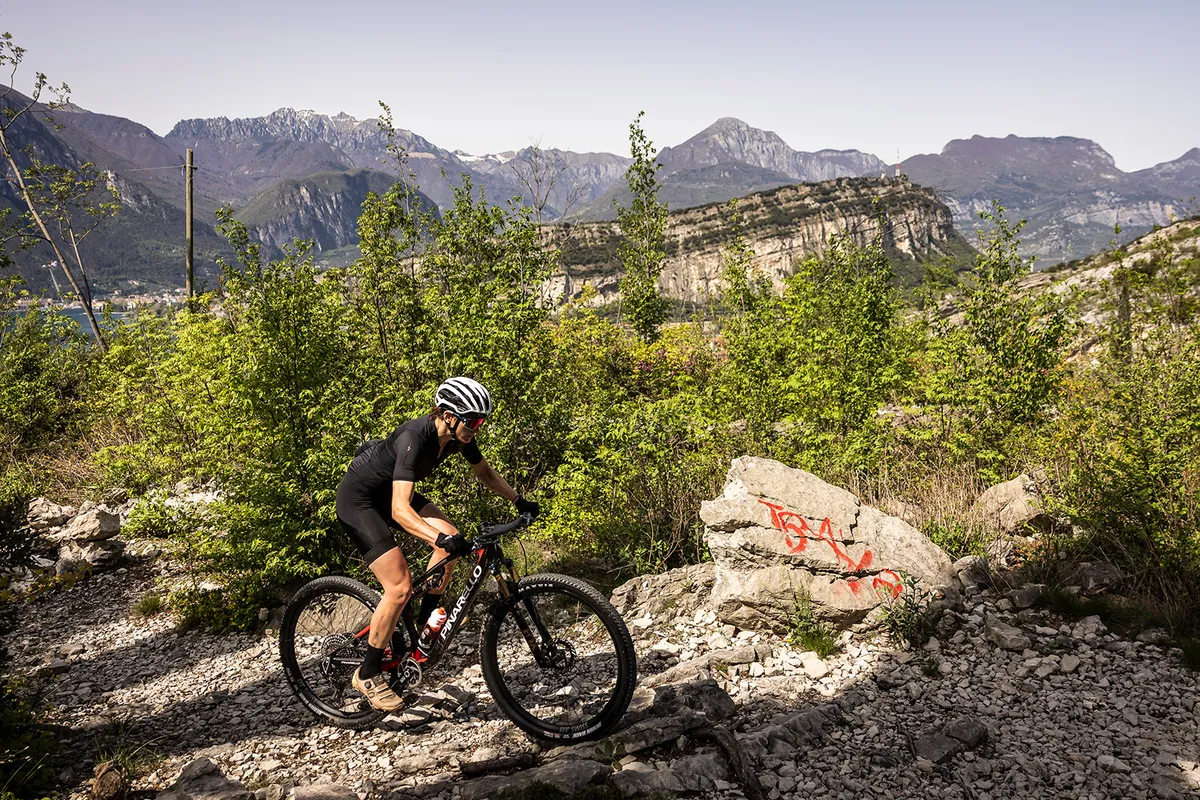
The Dogma XC felt most at home on the climbs.
Tom Pidcock prioritised lateral stiffness in designing this bike, aiming for optimal power transfer when cranking hard on the pedals and out of the saddle. Pinarello has executed this vision exceptionally well. The frame is noticeably stiff and very reactive when power is applied.
It was a joy to climb, whether on smooth or rough terrain. Technical climbs were made enjoyable thanks to the manoeuvrability and excellent traction offered by the short rear end of 425mm.
The lockout works well on asphalt or tracks. Complete lockout provides no pedal bob, so all your power goes into forward motion. The lockout levers were easy to use and clicking through to the medium setting provided a perfect balance of traction and support for maintaining forward movement.
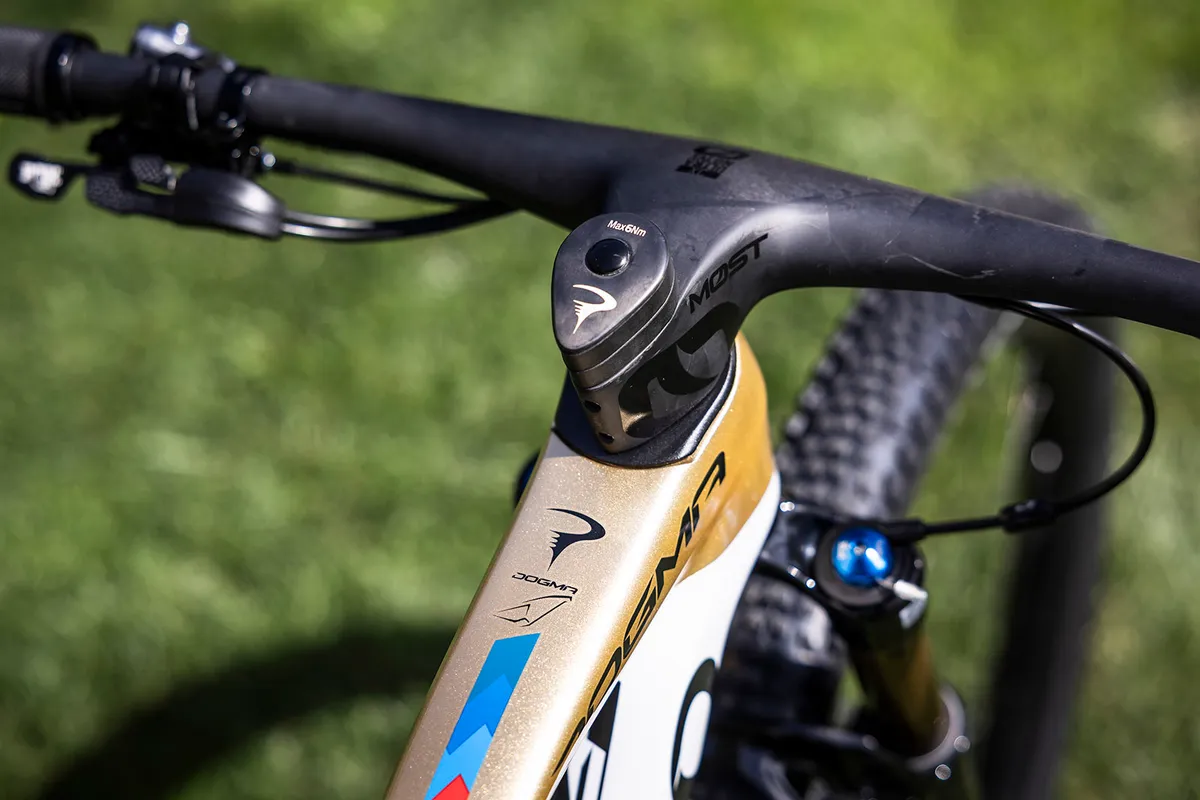
The stiff feel of the frame and its reactiveness is the most noticeable thing that sets the Dogma XC apart from other cross-country bikes on the market.
The setup of the cockpit, with the integrated bar and stem, and its negative rise, forces you into a forward position – which is great for attacking and getting in an aerodynamic position.
Pinarello Dogma XC descending performance
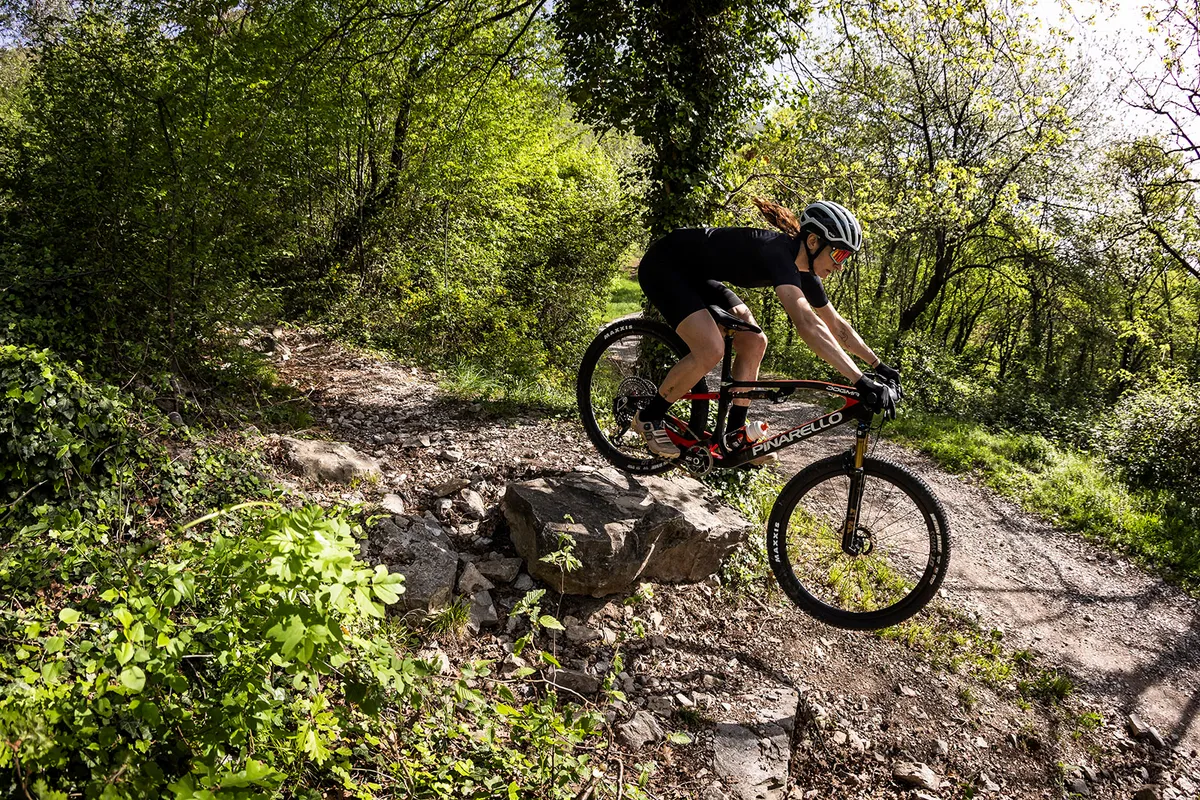
When it comes to going downhill, you can tell this bike has been designed by racers. It has an uncompromising feel – you have to be precise and committed to get the best out of this bike.
Initially, I set up the suspension as I do on the Orbea Oiz M-Team, Orbea’s XC race bike. However, I had to remove more than 40psi from the shock and still couldn’t get use of the full travel.
The bike is designed for a very specific kind of rider, and I feel optimising its performance will require a great deal of time to dial in the settings – something we didn’t have the luxury of during the launch.
The geometry and the negative-rise stem put you in a forward-leaning position, which can feel a bit precarious on descents, especially when grappling with suspension that requires significant setup.
Some integrated handlebar and stems can feel harsh, but Pinarello has managed to strike the perfect balance between torsional stiffness and a bit of flex, so I didn't feel any bar buzz or fatigue in the arms on the short descents we rode.
Pinarello Dogma XC early verdict

Early impressions are that this is a high-performance bike that will only suit a very specific sort of rider.
The stiff frame means power transfer is exceptional, and when you put the power down out of the saddle the bike flies. It is great fun on the climbs – it feels as though every ounce of your effort is being used to propel you forward.
While undoubtedly capable, this bike demands a skilled rider for optimal performance on descents.
The Dogma XC would be ideal for competitive riders focusing solely on racing. If you're after a more forgiving ride, that’s equally fun on trails and racetracks, exploring other options may be wise.
I'm hoping to get the bike in for some further testing, so I can spend some time getting the setup dialled for my specific riding style. This will enable me to fully review the capabilities of this bike for those of us who are not world champions.
Product
| Brand | Pinarello |
| Price | €13500.00, £12000.00, $13000.00 |
| Weight | 10.45kg |
Features
| Fork | Fox 32 Factory Kashima 100mm |
| Stem | Talon Ultra XC integrated |
| Frame | Toray M40 J Carbon Fibre |
| Tyres | Maxxis Rekon Race 29x2.35 EXO TR 120TPI (f) and Maxxis Rekon Race 29x2.25 EXO TR 120TPI (r) |
| Brakes | Shimano XTR |
| Cranks | SRAM XX SL Eagle AXS |
| Wheels | DT XRC 1200 Spline |
| Shifter | SRAM XX SL Eagle AXS |
| Cassette | SRAM XX SL Eagle AXS |
| Seatpost | Fox Transfer SL Kashima D30.9mm Drop 100mm |
| Handlebar | Talon Ultra XC integrated |
| Rear shock | Fox Float SL Factory Kashima 190x45 |
| Available sizes | S, M, L, XL |
| Rear derailleur | SRAM XX SL Eagle AXS |
